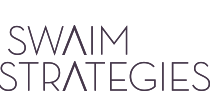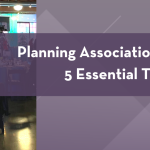Planning the Perfect Nonprofit Event: A Comprehensive Guide
Most nonprofit organizations host several events throughout the year. While most of these events may be for fundraising purposes, some of them will have other objectives in your fundraising cycle, such as donor acquisition or engagement. Regardless of your nonprofit’s goal, you’ll want to carefully plan your event to ensure it is a success.
Although the charity event planning process may seem daunting, it can be broken down into a series of easily manageable steps that a nonprofit of any size can follow. This article will help you plan your next event by covering the following topics:
- Benefits of Hosting a Nonprofit Event
- Benefits of a Clear Nonprofit Event Plan
- 9 Steps of Nonprofit Event Planning
- Working with a Nonprofit Event Consultant
No matter what type of nonprofit you have or what size it is, you can host a successful charity event. Before we cover how you can plan amazing events, you first need to understand the different ways they can aid your mission. Let’s dive into the benefits of hosting a nonprofit event!
Benefits of Hosting a Nonprofit Event
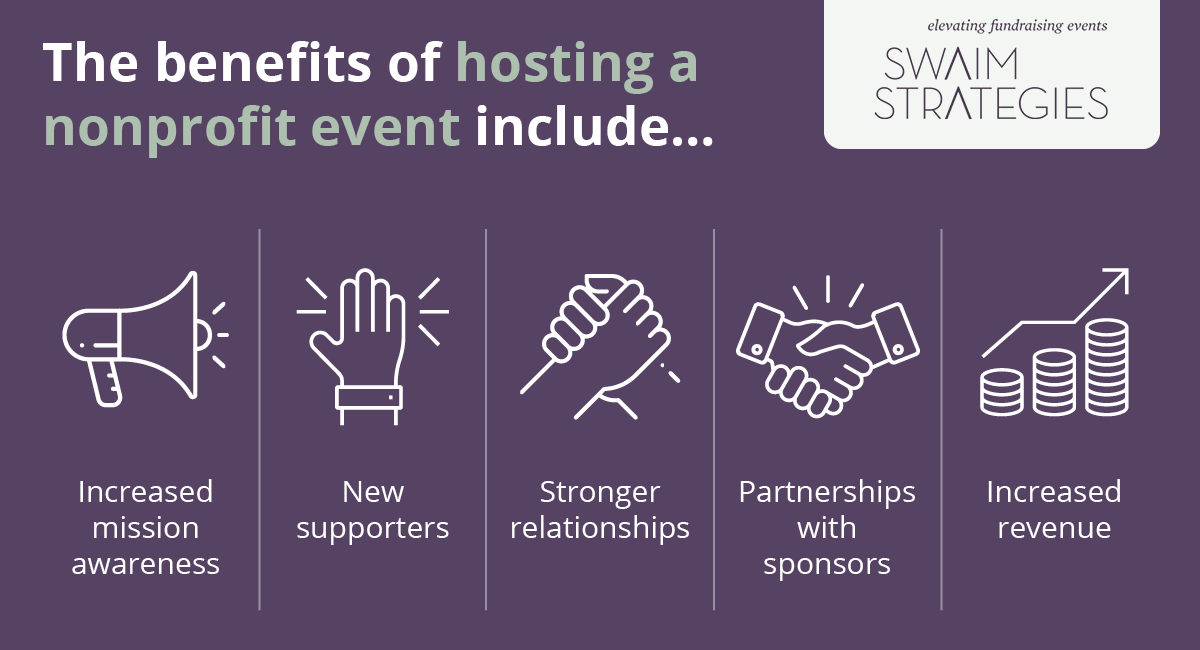
The benefits that your nonprofit will gain from hosting an event depend mostly on the purpose of that event. However, some common benefits include:
- Increased awareness of your nonprofit’s mission. When you promote your event to encourage attendance, you are also promoting your nonprofit’s work and initiatives, leading to increased awareness of your mission.
- Acquire new supporters. While many attendees may be already familiar with your nonprofit, your event will also attract individuals who had no previous knowledge of your organization, allowing you to gain new supporters.
- Stronger relationships with existing supporters. Giving your supporters time to connect with your staff, providing them with a positive guest experience, and telling the stories of your mission are powerful ways to build stronger relationships with existing supporters.
- New partnerships with sponsors. Aim to have 50% of your revenue be from sponsorship support. This allows you to bring in business partners, cover the costs of your event, and bring new donors to your event. When identifying potential corporate partners, look to your board’s employers, corporate partners already engaged in your mission, and new partners who clearly align with your work. For example, if your mission is to address food insecurity, look to food producers as a strategic corporate partner alignment.
- Increased revenue. A focus on relationships, storytelling, and your revenue strategy throughout the event planning process will lead to increased revenue that your nonprofit can put towards fulfilling your mission.
With all that your nonprofit stands to gain from an event, it’s worth it to take the time to create a thorough plan to ensure that you reap all the benefits that you can. Consider how you can maximize these benefits and how you’ll use them to secure your nonprofit’s future.
Benefits of a Clear Nonprofit Event Plan
Now that you understand the advantages your nonprofit can gain by hosting a charity event, you are probably eager to dive directly into organizing your next event. However, we advise you to take a moment to create a clear plan. Establishing a thorough plan for your nonprofit event has several benefits, including:
- Tangible vision. Having a plan will give you a concrete idea of what your event will look like and the actionable steps to take to make that event a reality.
- Saving time. With a clear nonprofit event plan, your staff and volunteers will all be on the same page regarding what the event will look like. This results in smoother teamwork, allowing you to efficiently organize a great event.
- Reduced stress. The idea of hosting an entire event may be overwhelming. Your event plan will help reduce that feeling, as it will break up what you need to do into manageable steps.
- More available options. When you know what you need early on in the event planning process, you’ll have more options for reserving the event location, setting the date, booking live entertainment, and so much more.
- Higher turnout. As a result of efficient organization, you’ll be able to release promotional materials earlier on. More supporters will see these materials and commit to attending your event, resulting in a higher turnout.
- Revenue growth. By building a plan in advance centered on clear targets for solicitation, prospects, and your revenue strategy, it is easier to engage your nonprofit’s leaders, board, and team with clearly defined goals and asks to be made. This will set you up with a clear path for revenue growth.
Every nonprofit planner has a full plate. To help streamline your planning process and result in the biggest return on investment, spend your time and energy establishing a clear plan with a focus on building and maintaining relationships. Additionally, consider taking the time to create event planning templates, ensuring that any future event planning is more convenient for your team members.
9 Steps of Nonprofit Event Planning
You may be wondering what to start with when planning your nonprofit’s event—take a look at the steps below to get an idea of what the event planning process looks like. When organizing your own event, you may be able to follow this list exactly, or you may want to add or remove steps according to your nonprofit’s unique needs.
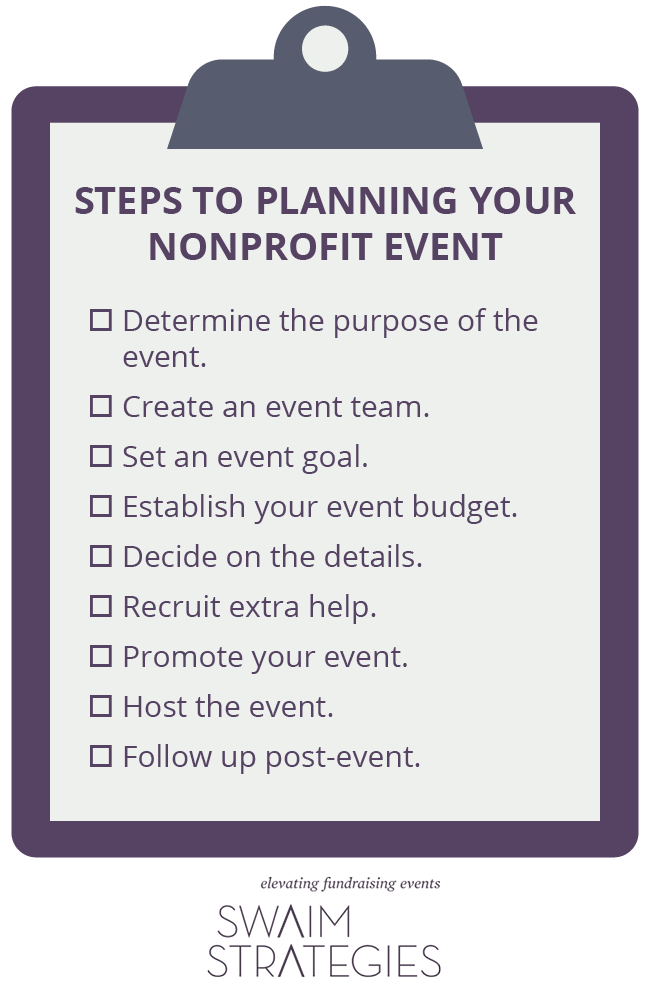
1. Determine the purpose of the event.
The first and most essential step to creating a successful event is to decide what its purpose is. Ask yourself, why are you hosting the event? What do you hope to accomplish with it? How will it help you with your nonprofit’s overall mission? Some common reasons why nonprofits host events include:
- Increasing cause awareness
- Recruiting new supporters
- Showing appreciation for existing supporters
- Raising funds
Ask yourself, what impact you can create by bringing several hundred people together? What do you want them to be talking about when they leave? Being able to answer these questions will help you to make decisions about theme, program, speakers, storytelling, and guest experience. You’ll be able to tailor your event to its purpose, keeping your team on the same page and driving the impact you desire.
2. Create an event team.
Depending on the size of your nonprofit, you’ll want to delegate the responsibility of organizing the event to specific individuals. These people may be:
- Staff members
- Board members
- Key volunteers
Choose individuals with the skills, roles, and experience that make them best suited for event planning. For example, your board is a resource to engage sponsorships, host tables, and secure auction packages. On the other hand, a volunteer committee might be able to support specific logistics needs like decor, entertainment, and wine donations. As an event planner and staff member, center yourself as the primary caretaker of relationships, and deploy your board and committee to support outreach and execution.
3. Set an event goal.
Your event goal should be based on the purpose of your event, and it should be specific, measurable, and realistic. Think of every event as an opportunity to create shared beliefs and language and build strong relationships. For example, if your event’s purpose is to gain support for a new initiative, design the event program to share the goals of the initiative and ask attendees to pledge their endorsement.
4. Establish your event budget.
Consider your nonprofit’s overall budget and how much of it you can allocate to this event. Your event budget should account for each of your areas of revenue and specific prospects that will help you reach your goal. For example, you might know that you need two sponsors at the $10,000 level to hit your event’s fundraising goals. In that case, your budget should identify at least two to four prospects that you can solicit for those giving levels. Although many event planners focus on expenses when developing their event budget, a good plan will have a strategy for both the revenue goals and expenses outlined.
5. Decide on the details.
After you’ve made all of the big-picture decisions, it’s time to get into the details. Once you complete this step, you’ll have a tangible idea of what the event will look like. You’ll want to determine the following aspects of your event:
- Date. Decide on what day you’ll hold your event. Plan for a date that works in your team’s calendar that doesn’t conflict with any of your partner organizations’ events, and has available vendor options.
- Planning timeline. Allow yourself 6-12 months for planning so that you have enough time to solicit sponsors, allowing you to get into their budget cycles.
- Location. This can be a physical location or even a virtual or hybrid space.
- Theme. While not entirely necessary, having a theme will make your event feel more cohesive and professional. Your theme should serve your overall purpose—for example, if you’d like attendees to better understand housing needs, a circus theme would be a mismatch, whereas a building theme would fit the event better.
- Extra activities. Aside from the main attraction, what other activities do you want attendees to participate in? These could include a raffle, a board meet and greet, or a photo op.
- Roles for staff and volunteers. Assess what parts of your event you’ll want help with to create roles for your staff and volunteers. Make sure that they have a clear job description, understand what is needed of them, and know if there are any budget constraints to their role. For example, if your nonprofit is hosting a pride parade and wants to hand out water to participants to ensure everyone stays hydrated, give your volunteers a specific budget to purchase water.
- Registration. Consider how you want attendees to sign up for the event. This could be through a new page created on your nonprofit’s website, or you could work with a third-party registration program.
This step is where the event really begins to take shape and come to life. Brainstorm ways to set your event apart from those of other nonprofits, and add your own unique twist to activities to promote attendance. Don’t be afraid of using resources such as fundraising books or podcasts to inspire you and round out your details.
6. Recruit extra help.
Sometimes, in order to host a great event, you’ll need to ask for some outside help. Consider seeking out extra help in the form of:
- Sponsorships
- Table hosts
- Volunteers
- In-kind donations
The scope of your event may decide what type of extra help you need. For example, if you’re hosting a baking competition, you may want in-kind donations of ingredients and volunteers to help set up. If your event is a gala, on the other hand, you may want to partner with a winery to provide drinks to your guests.
7. Promote your event.
One of the most crucial parts of planning and hosting a charity event is promoting it. We recommend that every donor has 7-10 touches in both print and digital formats. To attract attendees, send promotional materials early through different marketing channels. Your materials might include:
- An event page on your website
- Save-the-date postcards
- Mailed print invitation
- Email newsletters
- Event reminder texts
- Social media posts
To most effectively promote your event, choose communication channels that your intended attendees frequently use and have access to. Digital marketing and promotion create awareness and buzz while print marketing creates action.
8. Host the event.
A great guest experience leads to increased giving and long-term investment in your mission. Be an active host, have fun, and celebrate each of your speakers. And most of all, greet your guests and appreciate their participation in your event. People want to feel like they are a part of something and by being an active host you can help them to feel seen and celebrated.
9. Follow up post-event.
Your work isn’t done after the event is over. To help you meet your goals and solidify relationships, perform these follow-up actions after the event:
- Thank individuals for attending and giving. This will show attendees that you’re appreciative of their support, and will strengthen their relationship with your nonprofit. Engage your board in making follow-up phone calls to support your stewardship and relationship-building efforts.
- Ask for feedback. Asking for feedback allows you to engage with new and existing supporters, and gives you advice that you can act on to improve future events.
- Collect and assess data. Nonprofit events allow you to collect data on your attendees to learn more about them. You can assess this information to improve future supporter communications.
Keep in mind that your supporters are a wealth of information and they are the foundation of your nonprofit’s success. That’s what makes it crucial for you to steward the relationship after the event and solicit their feedback. Your supporters want your nonprofit to succeed just as much as you do, and they’re willing to give their opinions to help you do so. Consider the feedback and data you collect seriously and make changes to your event planning strategy for the future.
Working with a Nonprofit Event Consultant
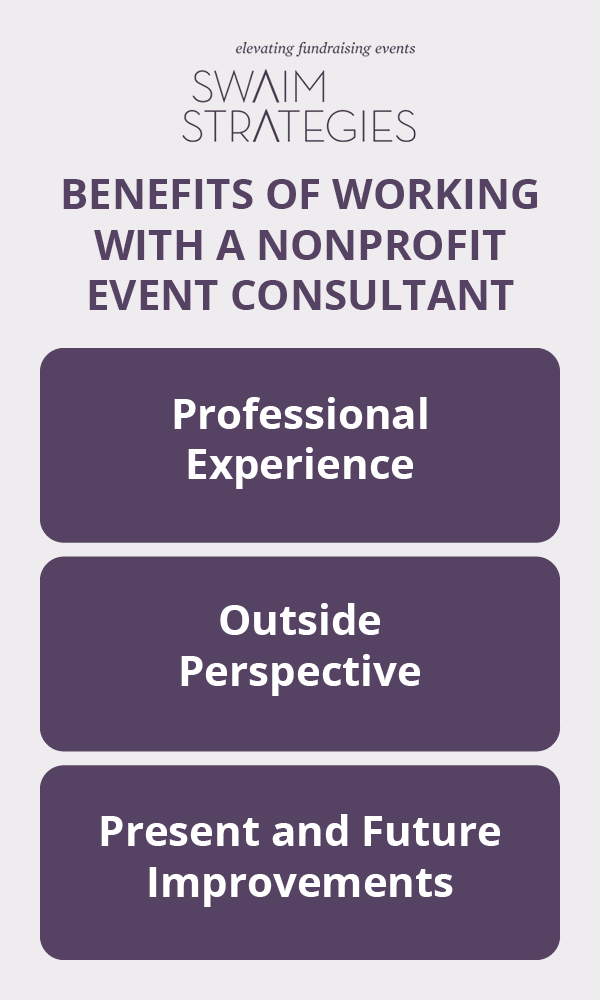
Planning a charity event can be an overwhelming process for nonprofits, especially if there isn’t a staff member with event planning experience to take the lead. In that case, consider working with a nonprofit event consultant. They will bring the following benefits to your nonprofit event planning process:
- Professional experience. Event consultants have years of experience working on nonprofit events of all kinds that they can leverage to help you plan a great event. Their depth of expertise allows you to learn from other organizations that the planner works with.
- Outside perspective. Sometimes an outside opinion can help you solve problems more easily. A nonprofit event consultant’s professional perspective can help shed light on your event, providing you with impartial advice. They can also help coach your board and committee along the way.
- Improvements. Event consultants can help you make improvements to your event plan now and help you form good event planning habits that will carry over into your future events.
Event consultants make the event planning process simple for all types of nonprofits, regardless of their size or mission. They can even create an entire event proposal for you, essentially outlining a detailed plan for your event.
For nonprofits that don’t require such a hands-on approach, some consultants allow you to book a short session with them where you can ask any questions you have and they can provide their professional advice.
Additionally, if you’re looking for more general knowledge on event planning, consider taking a fundraising course with a nonprofit event consultant. In these classes, you’ll learn more about nonprofit fundraising and gain the confidence to host a successful event of your own.
Conclusion and Additional Resources
Whether you’re hosting a fundraising lunch or a mission-centered experience to raise awareness, you’ll want to thoroughly plan your event to ensure that everything runs smoothly. Regardless of your nonprofit’s size or budget, you can organize an amazing event that creates the impact you desire.
If you’re still not feeling confident about your event planning process, consider attending our fundraising event conference. In it, you’ll learn more and gain the tools you need to maximize the potential of your fundraising events.
Interested in more resources on event planning? Check out the ones below:
- Elevate Nonprofit: Elevate Your Fundraising Event – Our fundraising event learning hub, Elevate Nonprofit contains event planning resources useful for nonprofits of all shapes and sizes.
- 5 Email Marketing Tips All Nonprofits Can Use – If you’re promoting an event to your supporters through email, take a look at this resource for some email marketing tips you can implement.
- 9 Must-Read Fundraising Books for Nonprofit Professionals – Ready to learn more about nonprofit fundraising? Learn about nine books that can help you upgrade your fundraising efforts.
